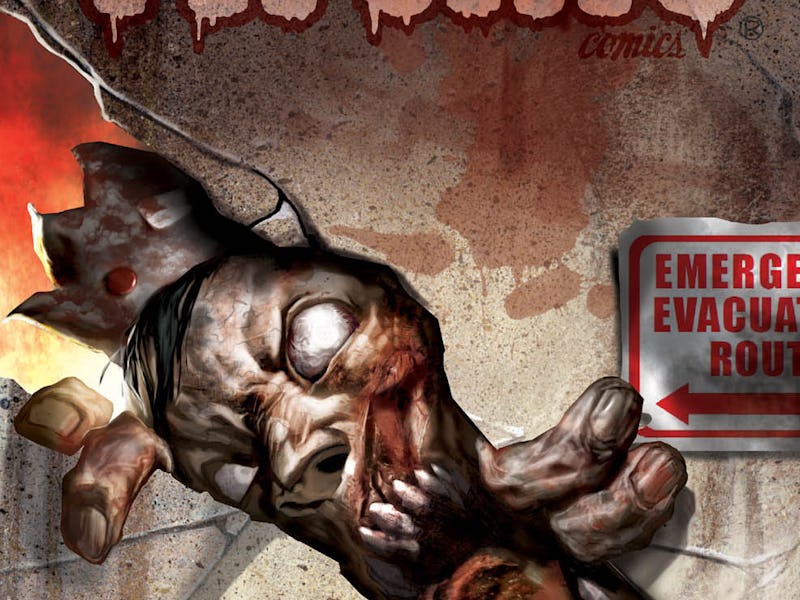'Afterlife With Archie' Is A Goddamned Twisted Masterpiece
Reggie kneels before Jughead's zombie dog, Hot Dog, now made Anubis, God of Death

What do we talk about when we talk about Riverdale? The sexy teens cast in the impending TV adaptation? The equally sexy version of Archie, Betty, and Veronica on comic stands, illustrated by Fiona Staples? We talk about Jughead’s sexual preferences — confirmation of his asexuality set Twitter on fire — and we ask whether Betty and Veronica’s perpetual conflict over who gets to go steady with Archie is anti-feminist.
What we should be talking about when we talk about Riverdale is the Archie Horror series that’s been painting the town red with Principal Weatherbee’s blood for months. Afterlife lampoons pulpy comics stylistically, but it also sinks its teeth in a thick slice of Charles Burns-esque, Black Hole feeling: teenage dread. Issue 9 dropped this week, and it is, quite simply, a bone-chilling nightmare, and a ton of fun.
Afterlife with Archie, a zombie comic that sometimes crosses over with the equally fantastic Chilling Adventures of Sabrina is a deep dive into Reggie Mantle’s psyche. What makes Afterlife so transfixing is its respect for Riverdale’s historical scaffold. Reggie has always been troublingly selfish and manipulative, even in the early ‘50s era comics, in which his modus operandi typically involved something benign – like splattering paint on Archie’s old jalopy.
Roberto Aguirre-Sacasa has a sick sense of humor and a clear understanding of what makes each character in the Archie pantheon tick; in Afterlife, he turns each static character inside out, making a gruesome spectacle out of some (Jughead), and simply allowing others the narrative space to reveal their true natures (Reggie).
I didn't know I wanted to see Archie Andrews beat his father to death, but here we are.
Issue 9 ramps up the brutality by placing us inside Reggie’s head as he takes an online sociopathic “test” with Archie and Jughead. The comic unearths Reggie’s personality disorder by defining it, and then places him in a high-stakes situation. Francesco Francavilla and Robert Hack, Afterlife’s artists, reveal a selfish, more dangerous Reggie by illustrating him peering at Midge from behind a locker door. We see Midge with her iconic boyfriend Moose in one panel, and in the next, Reggie sneers, a text box proclaiming in italics: “The little tease.” Reggie suggests that he and Midge have spent dark nights in his car together, and in a shocking panel (for a canon Archie comic!), we see him lying shirtless in bed with his eyes closed, saying Midge’s name with a single, telling line drawn above his arm to indicate motion just below the panel frame.
This isn’t simply Betty and Veronica and Zombies – though it was, undoubtedly, pitched that way to publishers. There’s a genuine, deeply satisfying horror in watching these characters, who previously were threatened only by banana peels and mop handles, face each other’s darkest urges. What’s more, these scenes are wickedly, almost cruelly, funny. When Reggie confesses that he was the hit and run driver who killed Jughead’s puppy, Hot Dog, which was a part of the multi-step process which led to the zombie apocalypse, he wanders into the woods and comes across the dead dog, now the leader of the undead. “I kneel before it,” Reggie narrates, “Hot Dog, now Anubis, the Jackal, the God of Death.”
The language used here may not be particularly natural for the Riverdale universe, but after only nine issues, Aguirre-Sacasa has more than earned his right to plug Reggie into the great evil building around him. Reggie, like the other members of the Riverdale gang, is smarter in Afterlife than he and his peers were defined in early Archie comics. It seemed, at first, a strange choice on Aguirre-Sacasa’s part to make Jughead the central ghoul, as he was the most natural choice for a capable, horror-comic protagonist. Jughead has always been two steps ahead of his friends, unless there’s a hamburger involved, but in Afterlife, he’s two steps behind them, shuffling always forward, never ceasing, his screaming mouth hanging open in agony.
Afterlife succeeds at something incredibly difficult; though it’s technically a “dark reboot” of a popular, outdated franchise, it is both funny and self-aware –and truly disturbing in a way other, similar ventures couldn’t do. In a business where comics are sometimes boiled down to gimmicky, one-off shots in the dark —- see Scooby Apocalypse — Afterlife manages to wrench real art out of a conceit that feels silly, upon first glance. The comics have always been about teenagers who felt cataclysmic, exaggerated desire for each other, and they tripped all over themselves for decades just to feel validated. In Afterlife, we see Ethel, the large-nosed girl who occasionally chases Jughead in the original comics, even wearing hamburger-scented perfume to rev his engines, as she throws herself at a zombie Juggie and, on some level, enjoys him biting into her exposed neck.
Perhaps its most intelligent move is making its zombies something more sinister, perhaps borne of Sabrina The Teenage Witch’s haphazard experiment with the occult. There aren’t a diseased, politicized horde of walking dead, but a mob of characters who still remember their old alliances and grudges. The characters remember their origins, as the reader does, and that alone makes Afterlife a shining example of how to reboot old stories with vigor.